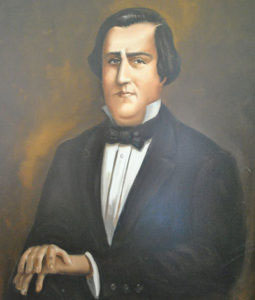
Alexander Philips was chiefly a commission merchant in grain and other commodities a field he inherited from his father Samuel Phillips. Before the era of the railroad, Fredericksburg played a major role in shipping throughout the Americas. After Samuel Phillips died, he used part of the estate to establish his own company A. K. Phillips and Co. Phillips was a diverse entrepreneur who served on the town council and owned a brewhouse, warehouse, three wharves, and a lumber yard in Fredericksburg. Like many 19th century businessmen, he branched out to become director or president of many businesses – banks, utilities, insurance, and transportation.
In 1855 he bought Mulberry Hill and 500 acres in Stafford and lived both there and in his mother’s residence on Caroline Street in Fredericksburg. The home was a two-story gothic revival with one of the few homes of the period with indoor plumbing. An indoor tank supplied water through silver faucets to marble basins. It became General Burnsides headquarters for the Battle of Fredericksburg. Later, it was gutted by fire in February 1863.
In 1876, A.K. Phillips and Co. built the present 7,000 square foot building, 100 Frederick Street as an office and warehouse for his import/export business. By that time Phillips was a coal and lumber merchant. Because of this use, the building is often referred to as the “Commission House.”
Alexander Philips purchased pew 92 at St. George’s for $300 in 1849 and was retained by the family until approximately 1939. Based on the CPI this would be $9,430 today. He began serving on the Vestry in the 1870s.
A significant achievement was the establishment of the National Bank of Fredericksburg, an independent bank from 1865 until bought by Mercantile Bankshares in 1994. In 1865 at the end of the Civil War, the Fredericksburg economy had been wrecked by destruction and needed capital for recovery. Confederate bonds were worthless. Phillips convinced Maryland friends to invest in 905 of 1,000 shares to help charter the National Bank on Oct. 11, 1865. Phillips served as president for 6 years. One historian writes “National Bank of Fredericksburg owes its existence to Alexander Keene Phillips.”
Phillips’ wealth like many of the local residents suffered declines in the Civil War years and was unable to purchase stock himself in the new bank. His taxable personal property was reduced from $23,310 in 1860 and $2,460 a decade later, mostly due to a decline in bonds. His real property also suffered a similar reversal.
Alexander Keene Phillips died in his 88th year in 1892, the oldest man in Fredericksburg. His obituary in the newspaper read, “He inherited the established business of his father and with singular prudence, steadfastness and sagacity he added to the high reputation of the old house by a course of life marked by the highest business intelligence and the most unsullied integrity. It may be said without qualification that the name of Phillips was wherever known, the symbol of confidence and trust.”
He and his wife are remembered in the Tiffany stained glass window, “Angel of the Resurrection” dedicated July 5, 1914, and given by their children.